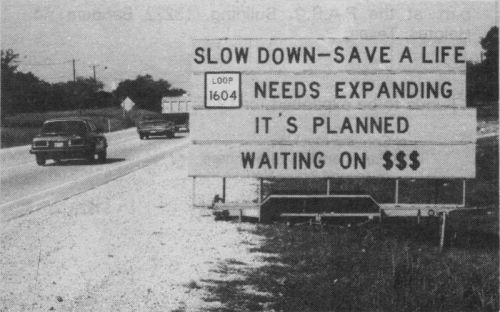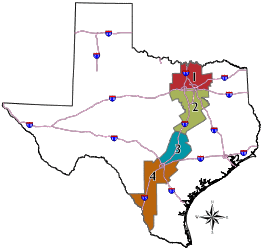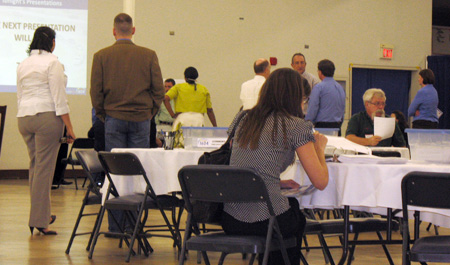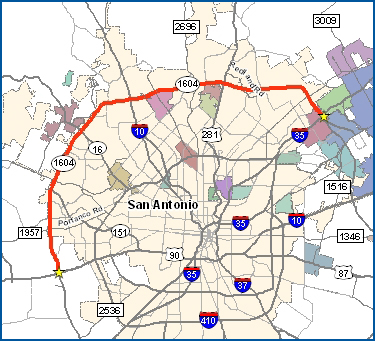Commuting Passenger rail Roads Safety Toll roads Travel: Interstate 35
by Patrick
Comments Off on Big plans for Texas’ worst highway (including tolls and rail)
Big plans for Texas’ worst highway (including tolls and rail)
Planners and pundits have long decried Interstate 35 as Texas’ worst highway.
Notorious traffic backups and numerous crashes on I-35, especially on the stretch from San Antonio to Austin, have spawned big-ticket projects such as the SH 130 tollway and Lone Star commuter rail. Putting two and two together from such thinking eventually led to the now supposedly defunct Trans Texas Corridor.
But more big plans are in the making.
Four committees, each looking at a segment of I-35, are holding public meetings this month to wrap up draft plans on what to do with the highway, its feeders and parallel roads. Billions of dollars worth of projects are eyed, including this for South and Central Texas:
- Convert one I-35 lane each way into toll/carpool lanes from Buda to Georgetown
- Remove tolls and widen SH 130 to six lanes from Seguin to Georgetown
- Build high-speed passenger rail from San Antonio to Dallas
- Build passenger rail from San Antonio to Laredo
- Widen I-35 from San Antonio to Laredo
Commuting Construction and closures Toll roads Transit: Loop 1604
by Patrick
1 comment
What’s in store for your Loop 1604 commute?
Here’s the gist of what’s being laid out, in a series of public meetings wrapping up tonight, for Loop 1604’s future.
The problem, officials say, is that traffic demand in 25 years will be twice as much as what can fit on the highway today. The lanes can currently handle about 80,000 vehicles a day, but demand is 110,000 now and will surge to 155,000 by 2035.
An environmental study is sizing up impacts of three basic strategies:
Buses and passenger rail. At best, this can meet 15 percent of demand when you consider that top-notch transit cities such as San Francisco, Washington and Boston snare about that much of the trips in those cities.
Managing and improving traffic flows. This is done with engineering, like the super street idea, and behavior incentives that range from carpooling to staggered work hours and telecommuting. California enacted laws requiring large employers to use such commuting strategies but cut traffic just 3 percent.
Adding four lanes to the highway. Since each lane can handle about 20,000 vehicles a day, that would do the trick.
So you can see where the math leads.
However, a dozen various community criteria will also drive decisions, and that produces a little more mix into the approaches.
Massive Loop 1604 study goes back to the public
The top ideas on how to add lanes to almost half of Loop 1604 will be laid out in a series of three public meetings this week so officials can get input.
With gas taxes strangled by decades of inflation, diversions and political inaction, toll fees and toll-backed bonds have emerged as a primary path to get some things done on the 37-mile stretch of highway.
A previous study was derailed in 2008 after toll opponents and environmental activists filed a lawsuit in a federal court. The lawsuit in part called for Loop 1604 and U.S. 281 to be studied together, since they would have been part of an interrelated tollway system, and the judge seemed to agree.
For this week’s meetings, study officials will provide several short presentations each night, from 6 to 8:30 p.m.:
- Monday, Valero Headquarters, Building D, One Valero Way.
- Tuesday, Live Oak Civic Center, Main Hall, 8101 Pat Booker Rd.
- Wednesday, Vale Middle School, cafeteria, 2120 N. Ellison Dr.
For more information or help, start out at More for 1604’s event page.
Other links:
Automobiles Bicycles Commuting Roads Toll roads Transit Travel
by Hugh
Comments Off on 2005 Dodge Caravan 4th anniversary
2005 Dodge Caravan 4th anniversary
This is somewhat obscure but while searching through papers for the upcoming tax adventure, I happened upon the original sales document for my 2005 Dodge Caravan which I purchased exactly four years ago to the day, March 28, 2006. Since then I have added 69,271 miles to its already high one year total of 28,702 – it was probably a rental that maxed out early – making a grand total, as of today, of 97,973. more »
Commuting Passenger rail Roads Toll roads Transit: Broadway South Alamo Street streetcars U.S. 281
by Patrick
Comments Off on Streetcar dreams: Now it’s time to talk money
Streetcar dreams: Now it’s time to talk money
After starting the fiscal year by shaving $19 million in spending, including 330 jobs, the city is now being asked to kick in $17 million to build a two-mile streetcar line.
That’s just part of the bill to buy streetcars and lay rails along Broadway and South Alamo Street by 2014. The county, VIA Metropolitan Transit and the federal government could also pony up to help pay what would be an estimated $90 million.
City Council heard the pitch this afternoon.
“If there was any sticker shock … council members mostly kept it to themselves,” the Express-News wrote.
The city hasn’t made any commitments, at least not yet.
At $45 million a mile, the price tag is quite a bit cheaper than, say, turning U.S. 281 out by Stone Oak into a superhighway, or, I should say, tollway.
Ah, but already I’m talking apples and oranges. This quaint two-mile rail line wouldn’t be a wide commuter route helping connect San Antonio’s core to its fringes.
Nope, unlike U.S. 281’s role as an artery for sprawl, the rail line, if done well, would be a magnet for compact living, working and playing. The idea is to drive some growth to the inner city, by creating a place where people would gladly leave their cars behind more often. Tourists would love it too.
Nonetheless, critics and proponents will duke it out with such comparisons. And with so many angles on varying public and private costs, some visible and some not so visible, expect a debate that’s about as clear as mud.
Docs and links:





